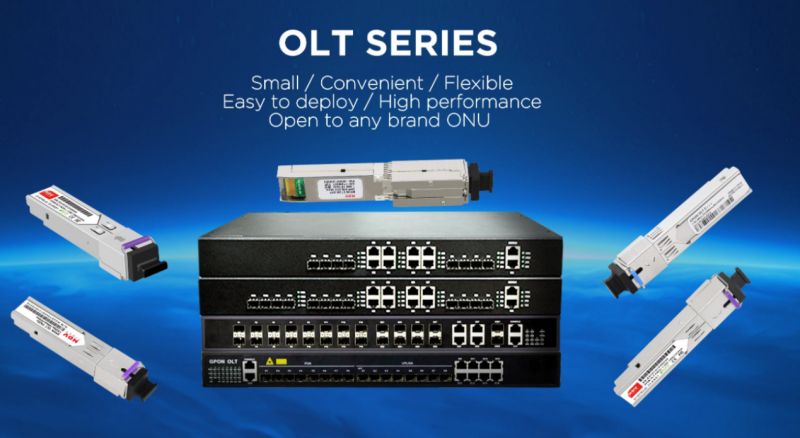PON Network
The so-called PON network consists of three parts: OLT, ODN and ONU.An OLT device is located at the core of the network topology. It accesses multiple service networks upward and services of multiple users downward through the ODN. It is an important node for service aggregation and distribution.OLT simultaneously realizes many network management functions such as control, management, ranging and so on to the client device ONU. OLT devices are the core of PON network both in terms of it’s network location or network function. With More and more services such as Internet access, 4K IPTV video, smart home services, small and medium-sized enterprise dedicated lines, IMS voice, and mobile backsend are carried on the PON network, the demand for bandwidth and the level of refinement of management continue to increase .The development of PON technology and the deployment and evolution of OLT devices play a crucial role in the development of broadband access networks.
Analysis of the PON network status
(1) OLT equipment deployment
The OLT equipment of domestic operators was basically deployed in 2006, and was mainly used for PON + DSL access in the initial stage. Since 2009, FTTH has been deployed on a large scale for more than 10 years. According to the slot bandwidth, the switching capacity of the whole machine, and the support for PON board card, there are 2~3 generations of products are running in the current network.The single slot switching capacity of the manufacturer’s main push equipment in the current network operation reaches 40G/ slot, and all support 10G EPON and XG-PON1.
(2) PON technology deployment
With the gradual commercial use of 10G PON technology, PON cards configured by OLT devices in the current network are divided into four types: EPON, GPON, 10G EPON and XG-PON, among which EPON and GPON are the main ones.
Under the promotion of the improvement of EPON standards by China Telecom and China Unicom, the domestic operator EPON is commercialized about 2 to 3 years earlier than GPON. Before 2013, the construction was dominated by EPON, and then, due to the advantages of GPON in bandwidth, it gradually occupied a dominant position in OLT construction. From the perspective of the current network stock deployment, the OLT equipment of China Unicom and China Mobile is mainly GPON, while China Telecom is mainly EPON.
10G PON Construction began around 2015. As the price of 10G optical module is always high, the price of 10G PON ONT is about 5 times that of the existing EPON / GPON terminals. In the current environment where operators generally give terminals to customers, and the business demand is basically below 100 Mbit / s, all major operators are cautious about the deployment and application of 10G PON. At present, the construction mode of 10G PON is mainly applied in 10 GPON + LAN and FTTH deployment.10 GPON + LAN is mainly to transform the existing cell LAN, network and PON + LAN network. On the one hand, it solves the problem of insufficient bandwidth caused by the high number of access users; on the other hand, since multiple users share the price of optical module in the MDU, the overall cost increases little compared with PON + LAN, so it has a large-scale application, and both 10G PON and XG-PON are adopted. The construction of 10G PON FTTH is mainly a pilot project carried out by various operators. The main purpose is to publicize and verify the products of 10G PON FTTH.
The above is the explanation of the overall structure of PON network. The network products of Shenzhen HDV Photoelectronic Technology Co., Ltd. are all equipment produced around PON network, including ONU series / OLT series / optical module series / transceiver series and so on.
